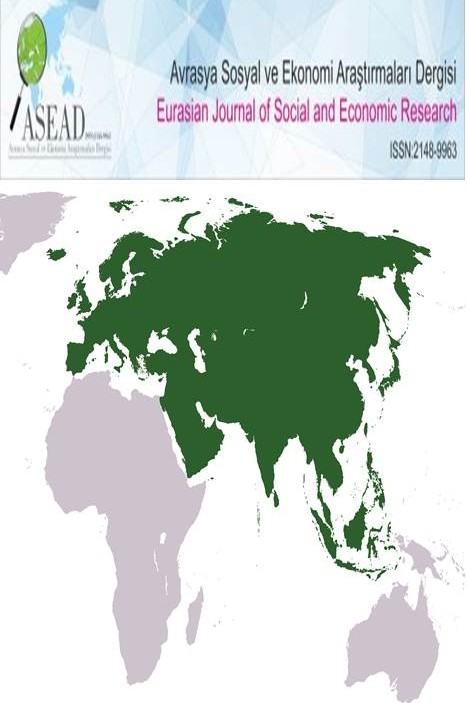A COMPARISON FOR ENVIRONMENTAL SUSTAINABILITY PERFORMANCES OF THE TURKISH METROPOLITANS’
Environmental Sustainability, Analytic Hierarchy Process, Sustainability, Sustainable Cities, Multi-Criteria Decision Making, Urban Sustainability
___
- ACZEL, J., SAATY, T. (1983) Procedures for Synthesizing Ratio Judgements. J. Math. Psychol., 27, 93–102, DOI:10.1016/0022-2496(83)90028-7.AL-SAIDI, M., BİRNBAUM, D., BURITI, R., DIEK, E., HASSELBRING, C., JIMENEZ, A., WOINOWSKI, D. (2016) Water Resources Vulnerability Assessment of MENA Countries Considering Energy and Virtual Water Interactions, Procedia Engineering, 145, 900-907, DOI: 10.1016/j.proeng.2016.04.117.EPI (2012) Environmental Performance Index, http://www.ciesin.org/documents/2012-epi-full-report.pdf (25/10/2018).EPI (2018) Environmental Performance Index, https://epi.envirocenter.yale.edu/epi-topline (25/10/2018).EVI (2005) Environmental Vulnerability Index, http://www.vulnerabilityindex.net/sdm_downloads/934/ (25/10/2018).GDF (2015) Republic of Turkey General Directorate of Forestry. https://www.ogm.gov.tr/lang/en/Pages/Forests/TurkeyForests.aspx (25/01/2019).GÓMEZ-NAVARRO, T., GARCÍA-MELÓN, M., ACUÑA-DUTRA, S., DÍAZ-MARTÍN, D. (2009) An Environmental Pressure Index Proposal for Urban Development Planning Based on the Analytic Network Process. Environ. Impact Assess. Rev., 29(5), 319-329, DOI:10.1016/j.eiar.2008.10.004.KÖNE, A.Ç., BÜKE, T. (2017) Eco-Efficiency Analysis Using Analytic Hierarchy Process Approach. Int. J. Anal. Hierarchy Process, 9(2), 167-182, DOI: 10.13033/ijahp.v9i2.477.OECD (1999) Environmental Performance Reviews: Turkey, https://read.oecd-ilibrary.org/environment/oecd-environmental-performance-reviews-turkey-1999_9789264173804-en#page1 (08/01/2019).OECD (2008) Environmental Performance Reviews: Turkey (2008), http://www.oecd.org/env/country-reviews/environmentalperformancereviewsturkey2008.htm (10/01/2019) ISBN: 9789264049154. RUSSO, R.D.F.S.M., CAMANHO, R. (2015) Criteria in AHP: A Systematic Review of Literature. Procedia Computer Science, 55, 1123-1132, DOI:10.1016/j.procs.2015.07.081.SAATY, T.L. (1980) The Analytic Hierarchy Process, Planning, Priority Setting, and Resource Allocation. McGraw-Hill, NewYork, ISBN:0070543712, 9780070543713.SAATY, T.L. (1985) Analytical Planning the Organization of Systems, 1st Edition, Pergamon Press, NewYork, ISBN:9781483153964.SAATY, T.L. (1986) Absolute and Relative Measurement with the AHP. The Most Livable Cities in the United States. Socioecon. Plann. Sci., 20(6), pp. 327–331, DOI:0038-0121/86$3.00+0.00.SAATY, T.L. (2000) Fundamentals of Decision Making and Priority Theory with Analytic Hierarchy Process. RWS Publications, Pittsburgh, ISBN:1888603151, 9781888603156.SHW (2012) General Directorate of State Hydraulic Works, Land&Water Resources, http://en.dsi.gov.tr/land-water-resources (17/01/2019).TURKSTAT (2018) Regional Statistics, https://biruni.tuik.gov.tr/bolgeselistatistik/anaSayfa.do?dil=en (03/01/2019).TURKSTAT (2019) Gross Domestic Product by Province, 2015-2017, http://www.tuik.gov.tr/PreHaberBultenleri.do?id=30888 (17/01/2019).UNICEF (2010) http://www.unicef.org/infobycountry/Turkey_statistics.html#78, (24.11.2011).
- Yayın Aralığı: Yılda 4 Sayı
- Başlangıç: 2014
- Yayıncı: İrfan TÜRKOĞLU
Büşra AYDOĞAN, Süleyman KAHRAMAN
ÇALIŞMA HAYATINDA ALGILANAN BOŞ ZAMAN VE SANAL KAYTARMA
Hayret BAŞARAN, Özay Nuri AKSOY, Turgut KIVANÇ
Terekhin VYACHESLAV, Nuh Mehmet BÜYÜKSİVASLIOĞLU, Mustafa ŞEKER
VÜCUT ALGISI VE SOSYAL GÖRÜNÜŞ KAYGISI İLİŞKİSİNİN İNCELENMESİ
Mehmet YORULMAZ, Şenay KURUTÇU
SOCIOPOLITICAL SYMBOLIZATION OF STARI MOST: CONSTRUCTION, DESTRUCTION, RECONSTRUCTION
A COMPARISON FOR ENVIRONMENTAL SUSTAINABILITY PERFORMANCES OF THE TURKISH METROPOLITANS’
İŞLETME BÜYÜKLÜKLERİNİN MUHASEBE KALİTESİ ÜZERİNE ETKİSİ
